Grower-funded research projects
PLANT ESTABLISHMENT
Investigating wider row spacing in no-till canola: implications for weed competition, response to nitrogen fertilizer, and seeding rate recommendations
LEAD RESEARCHER: Chris Holzapfel, IHARF
FUNDING: SaskCanola
PURPOSE: The objective of this ongoing project is to evaluate the feasibility of growing canola at row spacing levels exceeding 30 cm (12″) and explore the potential implications of wider row spacing on side-banded N recommendations, optimal seeding rates and competition with weeds.
PROGRESS: Despite high weed pressure in both years, a single in-crop herbicide application kept weed competition acceptably low at all row spacing levels. The potential for increased risk of seedling injury with side-banded N at very wide row spacing exists, but N effects on emergence were similar and variable for 25 to 41 cm spacing. Despite the reduction in plant populations, particularly in 2013, canola responded well to side-banded N with sequentially increasing seed yields at all N rates, with maximum yield increases of 40 percent in 2013 and 370 percent in 2014. Averaged across other factors, row spacing effects on seed yield have been minimal or insignificant.
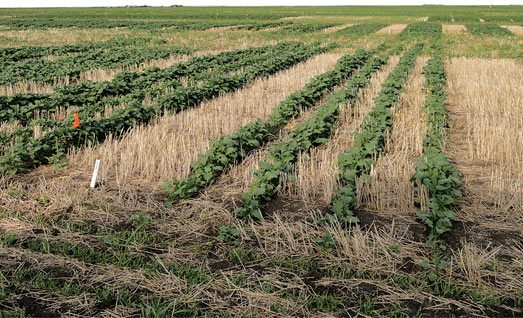
FERTILITY MANAGEMENT

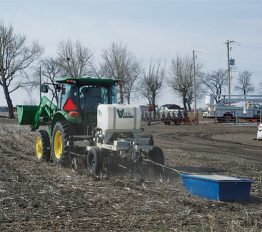
Understanding soil variability for effective zone management in precision agriculture: An evaluation of sensor-based mapping
LEAD RESEARCHER: Ken Coles, Farming Smarter
FUNDING: ACPC, Farming Smarter
PURPOSE: This study seeks to evaluate soil sensors as tools for understanding the spatial variability of soils, and their relationship to crop productivity. Soil sensors studied (Veris and EM38) generate geo-referenced maps of electrical conductivity, pH, organic matter and accurate digital elevation models when coupled with enhanced guidance systems.
PROGRESS: Preliminary results indicate that, despite the complexity of soil variability, electrical conductivity appears to be a reliable and static indicator of underlying spatial patterns in agricultural soils. Further analysis will assess the value of these layers of mapped data to manage production using variable rate technology.
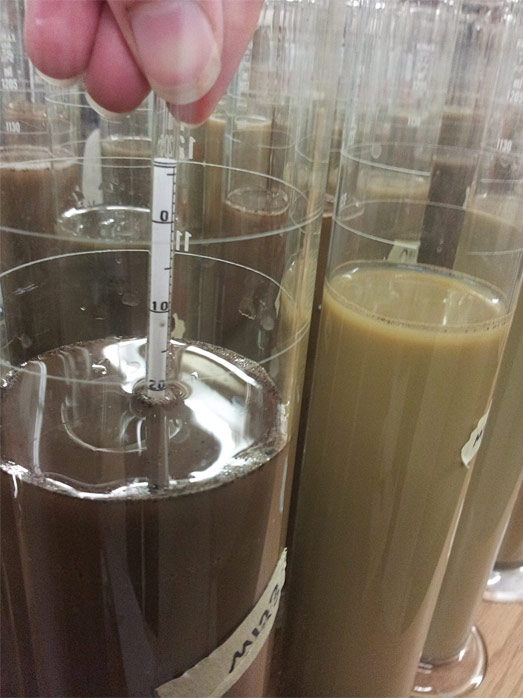
Transformations and fate of seed-placed sulphur fertilizers in Saskatchewan soils
LEAD RESEARCHER: Jeff Schoenau, University of Saskatchewan
FUNDING: SaskCanola, ADF
PURPOSE: To determine the fate of different forms of sulphur fertilizer applied in the seed-row of canola, peas and wheat.
PROGRESS: Little or no crop yield response (in wheat, canola or pea) to added sulphur (S) fertilizer may be anticipated in the Brown Soil Zone when adequate supplies of sulphate S are present in the sub-soil (as at the site used in this study). Soils with high organic matter and with good mineralization capacity for S, such as Black chernozems, also show reduced response. The most responsive soil to S fertilization was the Gray Luvisol, owing to lack of subsoil sulphate reserves and low S mineralization potential. Even with a history of good S fertility management, canola is likely to respond significantly to S fertilization on soils like these. As part of this study, the SXRMB beamline at the Canadian Light Source was used to track the oxidation of S fertilizers like elemental S into more oxidized forms, and eventually into plant-available sulphate. Results indicate oxidation of the elemental S fertilizer form (Sulvaris Vitasul) proceeded over the eight weeks following application in this study.
Improving growth and yield of canola with the novel fungal endophyte Piriformospora indica.
LEAD RESEARCHER: Janusz Zwiazek
FUNDING: Agriculture Funding Consortium, ACPC
PURPOSE: This project examines the effects of the novel growth-promoting fungus P. indica on the growth and yield of canola plants subjected to different phosphorus and nitrogen fertilization levels and environmental stresses. The main objective is to determine whether inoculating canola with this fungal endophyte can increase stress resistance, growth and yield, and reduce fertilization levels.
PROGRESS: The researchers examined the effects of P. indica on growth and yield of canola plants supplied with full (100 percent) and reduced (50, 25 and five percent) concentrations of nitrogen and phosphorus, and the drought stress responses. Seed production was strongly increased by fungal inoculation in canola plants regardless of phosphorus fertilization levels. However, the fungus had little effect on the growth and yield of canola plants subjected to drought stress and nitrogen deficiency.
Long-term residual effects of alternative nitrogen management practices in canola production systems
LEAD RESEARCHER: Ramona Mohr, AAFC Brandon
FUNDING: SaskCanola
PURPOSE: The objective is to determine the effect of different nitrogen (N) management practices over the course of a four-year canola-wheat rotation on N availability in subsequent growing seasons. Nitrogen availability following a crop failure versus a “bumper crop” is also being assessed.
PROGRESS: Year 2 of 2. Initial results suggest that N availability was influenced more by the productivity of the preceding crop than by preceding N management. In 2014, unfertilized wheat grown after a poor canola crop yielded 115 percent of unfertilized wheat grown after a highyielding wheat crop. Higher Greenseeker readings and grain protein levels suggested these higher yields were associated with greater N availability.
Assessing current soil test-based fertilizer recommendations for direct seeding systems to optimize crop production and contribution margin
LEAD RESEARCHER: Kabal S. Gill, SARDA
FUNDING: ACPC, ABC, AAF, local municipalities, SARDA
PURPOSE: Starting from 2010, cereal (wheat or barley) and canola responses to fertilizer rates (0, 60, 100 and 140 percent of soil-test based fertilizer recommendations) were assessed under conventional (CN) and direct seeding (DS) systems.
PROGRESS: From 2010 to 2014, crop yields always increased significantly with 60 percent rates while differences between 60 and 140 percent rates were not always significant. Maximum yields were observed at 100 or 140 percent fertilizer rates. Crop yields were usually higher from the DS system in dry years while no consistent differences between DS or CN systems were observed in years with normal rainfall. No consistent interactions were observed between the seeding systems and fertilizer recommendations. Compared to the cereals, canola yield with no fertilizer showed relatively steeper decline resulting in increased response to fertilizer with passage of years.
Identification of superior crop rotations to minimize inputs, optimize crop production and maximize contribution margin
LEAD RESEARCHER: Kabal S. Gill, SARDA
FUNDING: ACPC, APG, ABC, AAF, local municipalities, SARDA
PURPOSE: This study compared canola and wheat monocultures to two- and three-year crop rotations that included peas, barley and flax. The study began in 2009. Maximum amounts of N, P, K and S fertilizers were used in the canola monoculture.
PROGRESS: Including peas in a rotation reduced N use while absence of canola in a rotation reduced S use. Compared to crop rotations, canola monoculture was more sensitive to yield loss than the wheat monoculture. The 2010 to 2014 results showed average crop rotation benefits of 11.3 bu./ac. (20 percent) over the canola monoculture and 5.7 bu./ac. (nine percent) over the wheat monoculture.
Field proofing the use of plant hormones to increase canola, wheat and pea yields
LEAD RESEARCHER: Jocelyn Ozga, University of Alberta
FUNDING: ACPC, APG, AFC, University of Alberta, Syngenta
PURPOSE: Among the classes of plant growth regulators, auxins show some promise for enhancing the vegetative growth and yielding ability of specific crops. The project tested foliar application of the auxins 4-chloroindole-3-acetic acid (4-Cl-IAA) and 4-methylindole-3-acetic acid (4-Me-IAA) at an early reproductive development stage of canola, wheat and field pea.
PROGRESS: Overall, data suggest that one application of the auxins 4-Cl-IAA or 4-Me-IAA prior to or at flowering has the ability to increase seed yield of canola, wheat and field pea crops. Further testing is required to broaden our knowledge of the conditions and genotypes necessary to obtain optimal auxin response for increased seed yield under a variety of environmental conditions.
INTEGRATED PEST MANAGEMENT
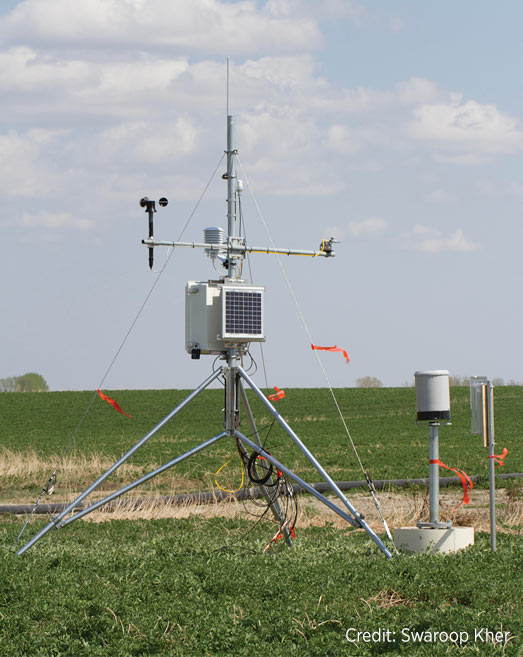
Development and implementation of a weather-based, near real time, crop insect pest monitoring/ prediction model and program for Alberta
LEAD RESEARCHER: Daniel Itenfisu, AAF Edmonton
FUNDING: ACPC, AAF PURPOSE: The aim is to develop and implement a provincial weather-based near real time (NRT) insect pest prediction model as a web-based risk management tool for three significant insect pests: bertha armyworm, alfalfa weevil and wheat midge. The models will provide a timely prediction of the pest phenology across Alberta and assist in devising effective pest management practices.
PROGRESS: Year 2 of 3. Progress includes a thorough literature review on pest forecasting systems, identification of appropriate pest models, design and implementation of pest phenology surveys and monitoring protocols across 100+ sites in 2014 and 2015. The researcher also made progress to design, deploy and operate near-realtime portable weather stations, and disseminated results through biweekly pest prediction maps.

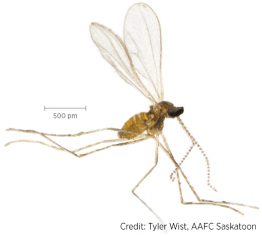
Aster yellows (AY) and swede midge: New threats to Prairie
canola production
LEAD RESEARCHERS: Tyler Wist, Chrystel Olivier, Owen Olfert,
Julie Soroka, Tim Dumonceaux, AAFC Saskatoon
FUNDING: ACPC, WGRF, ACIDF
PURPOSE: The purposes are to: determine the extent of infestation, evaluate yield losses, develop economic thresholds and forecast warnings, and identify resistant canola lines for AY and swede midge. AY: In the study years, the number of aster leafhoppers in canola across Saskatchewan was low and corresponded to a negligible incidence of AY symptoms in canola fields and commercial cultivar trials. However, aster leafhoppers were present and reproducing in cereal crops so “spillover” of adult leafhoppers at the edges of canola fields is probable.
PROGRESS: Year 3 of 3. AY: Several promising new techniques for the determination of AY infection in plants and leafhoppers have been developed, including a field test that yields results in less than one hour and is nearly ready for field testing. Swede midge: Although pheromone traps from only three of 150 locations across the Prairies tested positive for adult swede midge in 2015, damage surveys from Yorkton to west of Lloydminster found swede midge larvae in 15 canola fields. Two fields were in Alberta, the first record of the pest in that province.

Monitoring of swede midge populations in Saskatchewan and determining the impact of swede midge in different growth stages in canola
LEAD RESEARCHERS: Owen Olfert, Julie Soroka, AAFC Saskatoon
FUNDING: SaskCanola
PURPOSE: The purpose is to investigate the correlation between swede midge infestation and canola growth stage by determining the effects of early and late seeding on canola seed yields in midge-infested commercial canola fields.
PROGRESS: Year 2 of 3. Swede midge injury to canola was again light in 2015, but varied by location. One location — the driest site — had less injury than in 2014; one site had similar injury levels both years; and two sites had more injury in 2015 than in 2014. Few differences were found in injury between early and late seeded plots, and among plots using seed treated or not treated for flea beetle control.
Ecology of swede midge — host plant interactions
LEAD RESEARCHERS: Owen Olfert, Julie Soroka, AAFC Saskatoon
FUNDING: ADF, WGRF, SaskCanola
PURPOSE: The purpose is to investigate host plant susceptibility or resistance factors to swede midge, with the ultimate aim of identifying host plant resistance to the pest.
PROGRESS: Year 1 of 4. Researchers are currently compiling lists of plant species known to be swede midge hosts or non-hosts, collecting seeds of plants on the lists, and developing bioassay techniques in order to start experiments on midge-plant interactions.
Detection, identification and control strategies for cutworms on the Prairies
LEAD RESEARCHER: Kevin Floate, AAFC Lethbridge
FUNDING: ACPC, SaskCanola, AAFC
PURPOSE: This project was initiated to facilitate methods to identify and control species of cutworms that are pests of canola.
PROGRESS: Year 4 of 4. Results include: (1) the development of a molecular-based tool to identify key species of pest cutworms; (2) surveys of cutworms across the Prairie provinces; (3) identification of wasps and flies parasitic on these cutworms; (4) laboratory studies to assess the ability of select parasitoid species to develop on different cutworm pest species; (5) studies to assess the effect of seed cultivar, seed treatment and fertilizer regime on cutworm development; and (6) a cutworm identification guide (in preparation) for use by the agriculture sector.
Seed treatment as an alternative method to control aster yellows
LEAD RESEARCHERS: Bob Elliott and Chrystel Olivier, AAFC Saskatoon
FUNDING: SaskCanola
PURPOSE: The purpose is to evaluate seed treatments for control of leafhoppers and aster yellows (AY).
PROGRESS: Year 3 of 3. Laboratory assays on AY-infected leafhoppers at the cotyledon and early true-leaf stages identified treatments that provide the best leafhopper control and suppression of AY symptoms. In field trials on two canola types, leafhopper populations were very low whereas flea beetle populations were extremely high. Evaluations focused on identifying seed treatments that provide the best protection against flea beetle damage and the greatest improvement in seedling establishment, plant growth and seed yield.
Pollination management to maximize canola yield
LEAD RESEARCHERS: Shelley Hoover, AAF, Steve Pernal, AAFC Beaverlodge, Ralph Cartar, University of Calgary
FUNDING: Alberta Beekeepers Commission, ASCA, ACIDF, CCC
PURPOSE: The goal of this project is to quantify the contribution of managed pollinators to canola yield, and to provide management guidelines to maximize both pollination and bee health.
PROGRESS: Year 2 of 3. Preliminary results indicate that insect visitation to commodity canola flowers tends to decrease with depth into a field, whereas the volume of nectar available to pollinators tends to increase with distance from the field edge. In addition, data on honey bee hive management indicates a strong relationship between population size and honey production, however colonies managed as single brood boxes collected equivalent pollen to those managed in two brood boxes. Preliminary results from comparisons of honeybee hives used to pollinate hybrid seed production crops indicate that they produced less honey than those used strictly for honey production. Data on comparisons of colony health are ongoing. Observations in hybrid seed fields indicate that there are numerous behavioural interactions within and among pollinator species. Data also indicate that nectar resources are limited in these crops due to the high abundance of bees.
Coordinated surveillance, forecasting and risk warning systems for field crop insect pests of the Prairie ecosystem
LEAD RESEARCHER: Owen Olfert, AAFC Saskatoon
FUNDING: ACPC, SaskCanola, MCGA, WGRF
PURPOSE: The aim is to develop and implement insect surveillance programs to keep the Canadian agriculture industry informed of the risks to crop production from pest species and to highlight and conserve their natural enemies.
PROGRESS: Year 2 of 5. Sampling protocols have been developed or adapted for large-scale monitoring of a number of the major pests, and spatial analysis techniques have been developed and implemented to forecast their risks to crop production. Weekly updates were provided during the 2015 growing season and a new blog was developed for the Prairie Pest Monitoring Network: http://prairiepestmonitoring.blogspot.ca/.
Improving lygus management for current canola and faba bean cultivars
LEAD RESEARCHER: Hector Carcamo, AAFC Lethbridge
FUNDING: ACPC, ACIDF, APG
PURPOSE AND PROGRESS: Year 4 of 4. Lygus density treatments in the cages at all three sites — Lethbridge, Lacombe and Beaverlodge — seem to have succeeded in creating the variable insect pressures required to validate the thresholds using current hybrid cultivars. The cage study was supplemented with a plot spray trial. Preliminary regression analysis suggests a stronger negative relationship between lygus and yield during dry years. Yield and insect data are being processed for year four. Results will be presented at extension meetings in the winter.
Biology and management of glyphosate-resistant kochia
LEAD RESEARCHER: Bob Blackshaw, AAFC Lethbridge
FUNDING: ACPC, AWC, ABC, ACIDF, WGRF
PURPOSE: This study aims to identify cost-effective alternative herbicides to control glyphosate-resistant kochia in pre-seed, chemfallow, in-crop and postharvest applications. It also looks to determine the timing of seed maturity, seed production potential, and seed dormancy characteristics of glyphosateresistant kochia.
PROGRESS: The most effective rate of existing herbicides has been determined and conveyed to growers. Several unregistered herbicides show potential to control glyphosate-resistant kochia and data has been forwarded to the respective crop protection companies. Kochia emerging as late as mid-August can set viable seed before a killing frost. Seed loses dormancy a few weeks after maturity.
Emergence timing and management of cleavers in Saskatchewan canola crops
LEAD RESEARCHER: Chris Willenborg, University of Saskatchewan
FUNDING: SaskCanola, ADF
PURPOSE: Emergence timing of cleavers varies by population and most populations exhibit some level of spring and fall emergence. This study will work on differentiating speciation within the cleavers population, and look for potential herbicide solutions to cleavers management.
PROGRESS: Work is nearly complete. One of the products studied, clomazone, should soon be registered ahead of canola, and quinclorac is registered but does not have MRLs yet. Both of these provide excellent cleaver control when tank-mixed with glyphosate, glufosinate or imazapyr and imazamox.
Performance and cost of field scouting for weeds and diseases using imagery obtained with an unmanned aerial vehicle
LEAD RESEARCHER: Christoph Neeser, AAF
FUNDING: ACPC, AAF, ACIDF, WGRF, APG, AWC, ASCA, PGA
PURPOSE: The aim is to assess the usefulness of small, unmanned aerial vehicles (UAVs) for field scouting of weeds and diseases in major field crops.
PROGRESS: Images of alfalfa, barley, canola, peas, potatoes and wheat were captured over the 2014 growing season. For verification, selected areas were photographed from the ground following the capture of the UAV images. The image analysis is still in progress, but it is already clear that the 5 to 6 cm/pixel ground resolution is insufficient to substitute for in-person field scouting. Adjustments to the recommended protocol will focus on a two-stage approach, which will consist of identifying general areas of interest that will be inspected at close range with the use of a multi-rotor type of UAV.
Proof of concept to build a nano and antibody based pathogenspecific plant disease monitoring device for agricultural pest management
LEAD RESEARCHER: Xiujie Li, Alberta Innovates
FUNDING: ACIDF, ACPC, AITF
PURPOSE: The long-term goal is to develop an in-field sensor for the detection of plant disease pathogen levels (for disease prevention) and transfer the results to an electronic device in real-time fashion. The purpose is to prove that the potential sensor is feasible for spore detection.
PROGRESS: The study proved that lab nano-sensing technology could detect S. sclerotiorum ascospores and Leptosphaeria maculans with specificity. The spores and the impedance measurement on the sensor have a linear relationship. An in-field device is in progress.
Getting one step closer to sclerotinia control through cultivar resistance and biological applications
LEAD RESEARCHERS: Mark Belmonte, Dilantha Fernando and
Teresa deKievit, University of Manitoba
FUNDING: ACPC, SaskCanola, MCGA
PURPOSE: This study aims to identify genes and gene regulatory networks responsible for canola tolerance to sclerotinia in the presence of a bacterial biocontrol agent Pseudomonas chlororaphis. Tools include laser micro-dissection, next generation RNA sequencing and robust bioinformatics strategies.
PROGRESS: Researchers sequenced leaf tissue in tolerant and universally susceptible cultivars of Brassica napus in the presence of the fungus, the bacteria or both. They identified a suite of genes and plant defence pathways responsible for tolerance against the sclerotinia pathogen.
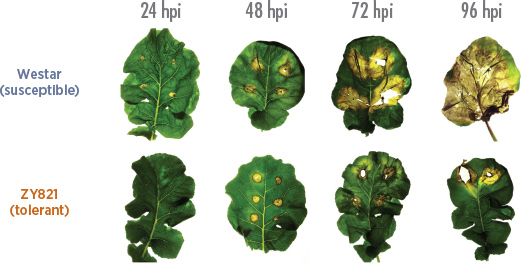
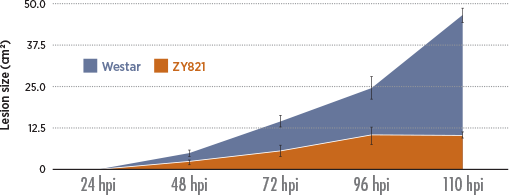
Improving sclerotinia disease control in edible beans and canola
LEAD RESEARCHER: Michael Harding, AAF
FUNDING: ACPC, WGRF, APG
PURPOSE: The objectives are to look for synergistic relationships between foliarapplied micronutrients and fungicides when tank mixed, and to evaluate the efficacies of “resistance-priming” chemicals as seed treatments to improve sclerotinia management.
PROGRESS: Year 3 of 4. A few synergistic combinations have appeared with the hope they will be verified to be consistent in all years tested. One of the resistance priming chemicals applied to seed has shown significant white mold reduction in two of three years in dry bean, but none of these compounds have shown any significant effect on stem rot in canola. Dry conditions in 2015 resulted in very little sclerotinia disease pressure, making it difficult to evaluate these seed and foliar-applied treatments.
Effects of genetic sclerotinia tolerance, foliar fungicide applications and their interactions on the incidence and severity of sclerotinia stem rot infection in Argentine canola
LEAD RESEARCHER: Chris Holzapfel, IHARF
FUNDING: SaskCanola PURPOSE: A three-year field study was initiated at five locations in 2013 to evaluate the merits of genetic tolerance and foliar fungicide applications for reducing sclerotinia stem rot infection in Brassica napus under field conditions. A secondary objective was to determine if, and under what conditions, foliar fungicide applications might be required when growing a cultivar with genetic tolerance to this important disease.
PROGRESS: While foliar fungicides tended to provide less consistent benefits with the tolerant hybrid, the results are not necessarily conclusive. At locations where disease was observed, foliar fungicides reduced sclerotinia incidence but only significantly increased seed yields for 45H29 at Melita in 2013 (according to the overall F-tests). So far, this study shows there is no benefit to a dual fungicide application over a single application, but this may not be the case under extremely high disease pressure. Field trials were conducted at all five locations again in 2015, the final growing season of the study.
Development of a rapid quantitative detection method for sclerotinia stem rot inoculum to aid disease risk assessments and fungicide spray decisions
LEAD RESEARCHER: Stephen Strelkov, University of Alberta
FUNDING: SaskCanola, ACPC, MCGA
PURPOSE: The purpose is to develop and refine a rapid quantitative method for pathogen detection on canola and flower petals.
PROGRESS: Final year. A quantitative PCR-based (molecular) method to measure the amount of DNA of the sclerotinia stem rot pathogen in canola petals has been developed. This method is both highly specific and highly sensitive for the stem rot pathogen. The relationship between the amount of pathogen DNA on the canola petals and final disease incidence and severity was investigated by collecting samples and monitoring disease development in fields in central Alberta and across the Prairies. Various parameters such as seeding date were also monitored and recorded. Analysis of this large dataset is nearing completion and will allow validation of the predictive potential of the test.
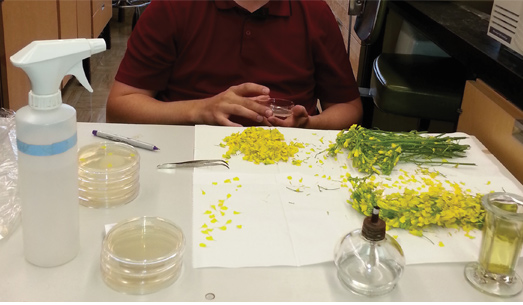
Analysis and monitoring of Leptosphaeria maculans race dynamics in Western Canada for effective use of cultivar resistance in management of blackleg on canola
LEAD RESEARCHER: Gary Peng, AAFC Saskatoon
FUNDING: SaskCanola, ACPC, MCGA, WGRF, ACIDF, ARDI and seed companies
PURPOSE: Analyze and monitor the blackleg pathogen population using Westar trap plots scattered on the Prairies to provide industry with up-to-date pictures of L. maculans race structure, as well as the pathogen race dynamics to guide cultivar selection and rotation. Additionally, certain severely diseased fields will be investigated to understand the role of L. maculans race changes in causing the cultivar to lose resistance to blackleg.
PROGRESS: Counts of 196 and 146 L. maculans isolates were collected from trap plots in 2012 and 2013 respectively, and tested on 14 host differentials for the presence or absence of avirulence (Avr) genes in the pathogen population. Overall, AvrLm1, AvrLm3, AvrLm9, AvrLep1 and AvrLep2 were found at low frequencies while AvrLm2, AvrLm4, AvrLm6 and AvrLm7 were found at higher frequencies. The pathogen population changed noticeably from that of 2007. AvrLm1, AvrLm3 and AvrLm9 almost disappeared while AvrLm7 increased substantially. Testing of 2014 samples is continuing.
Biocontrol of clubroot and blackleg by the endophytic microorganisms of canola
LEAD RESEARCHER: Paul Holloway, University of Winnipeg
FUNDING: ACPC, SaskCanola, MCGA
PURPOSE: Endophytes are bacteria and fungi that inhabit the tissue of plants without causing any harm to the plant. The goal is to find endophytes that may provide a benefit to canola.
PROGRESS: Researchers have isolated and purified a number of endophytic fungi and bacteria with several promising anti-bacterial and anti-fungal activities. Further testing will determine whether these endophytes also have activity against clubroot and blackleg pathogens and whether they can be used to protect canola plants.
Development and application of rapidly deployable in-field molecular diagnostics for plant diseases
LEAD RESEARCHER: Tim Dumonceaux, AAFC Saskatoon
FUNDING: ADF, SaskCanola
PURPOSE: The study will develop rapid diagnostic methods for a range of pathogens along with methods for rapid DNA extraction in a non-laboratory setting and apply these methods to the detection of crop pathogen DNA in agricultural products. We have targeted three diverse pathogens for initial development: aster yellows (phytoplasma), clubroot and blackleg.
PROGRESS: Field-deployable assays based on LAMP (loop-mediated isothermal DNA amplification) have been developed and validated for all of the targeted pathogens. The expertise developed while designing and validating these assays led the researchers to develop rapid diagnostic assays for other pathogens. They have also begun to perfect field-based DNA extraction methods for rapid and mobile pathogen detection.
Development of canola cultivar blackleg resistance groups:
feasibility evaluation
LEAD RESEARCHER: Ralph Lange, Alberta Innovates
FUNDING: ACPC, WGRF, ACIDF
PURPOSE: The objective is to determine if Canadian canola cultivars can be organized into resistance groups that would allow producers to choose cultivars with different blackleg resistance genes from those previously seeded.
PROGRESS: To date, researchers have adapted the Australian procedure by inducing ascospore formation in the residues. Early indications are that the number of resistance groups in Canada may be limited, so researchers have significantly increased the number of residue collection sites to decrease the chances of missing potential groups. They are currently collecting residues from blackleg-infested fields and strip trials. The procedure is to collect from fields and strip trials, transport residues to overwinter at Vegreville, and then inoculate field trials with the residues in the spring. They also test the residues indoors to further seek out putative resistance groups.
Toward a strategy for reducing the spore density and dissemination of clubroot of canola in Alberta
LEAD RESEARCHER: Sheau-Fang Hwang, AAF
FUNDING: ACPC, ACIDF, WGRF PURPOSE: The purpose is to develop a better understanding of the distribution and dispersal of clubroot and to develop methods to eradicate or reduce newly established infestations, both within fields and on a regional basis.
PROGRESS: Year 2 of 4. Resistant cultivars had very low indices of disease (0 to 6 percent) in most crops, however ID values of up to 20 percent were detected in some crops. In field experiments, susceptible cultivars contributed 2 x 108 spores/gram of soil, while resistant cultivars contributed 1.2 x 107 spores/gram of soil. Use of Vapam soil fumigant on clubroot-infested land improved crop establishment, plant height and seed production of plants and reduced clubroot severity.
Extent of infestation and potential for eradication of clubroot at sites in Saskatchewan
LEAD RESEARCHER: Bruce Gossen, AAFC Saskatoon
FUNDING: SaskCanola, ADF, WGRF
PURPOSE: This study assesses the potential for using fumigation to reduce or eliminate the resting spores of Plasmodiophora brassicae (the cause of clubroot) in new infestations and other situations where relatively small volumes of soil need to be treated.
PROGRESS: Two fumigants had good efficacy against clubroot under controlled conditions, but were less effective in the field. One issue that affects efficacy is that the spores of the pathogen are present at least one metre deep in the soil profile. Other factors that affect pathogen detection and fumigation efficacy are being examined.
Supporting continued development of clubroot resistant canola and early detection of clubroot outbreaks
LEAD RESEARCHER: Michael Harding, AAF
FUNDING: ACPC, WGRF, ACIDF
PURPOSE: The objectives are to evaluate canola lines and cultivars for their various levels of resistance to P. brassicae (pathotype 5) and evaluate the efficacy of soil amendments and treatments for clubroot management. Additionally, the project enhances clubroot surveillance in southern Alberta in attempts to rapidly identify any new introductions or outbreaks of clubroot south of Highway 1.
PROGRESS: Year 3 of 4. Dozens of new lines/cultivars have been screened, many of which have strong resistance to pathotype 5. Soil amendments and treatments have demonstrated limited ability to manage clubroot in areas with high resting spore populations. Clubroot surveillance has not discovered any new infestations south of Highway 1.
HARVEST MANAGEMENT
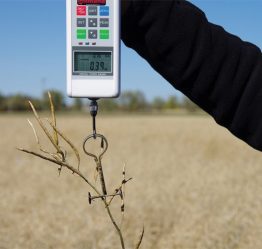 Developing a rapid method to evaluate pod-crop in canola
Developing a rapid method to evaluate pod-crop in canola
LEAD RESEARCHER: Rob Gulden, University of Manitoba
FUNDING: ACPC, SaskCanola, MCGA
PURPOSE: Pod retention-resistance is a new method under development to estimate pod drop potential among canola varieties. The method uses a digital force gauge to measure the force required to break the petiole of the pod at the rachis — the weakest point of attachment — and correlates this with pod drop measurements.
PROGRESS: Results among site-years showed consistent and significantly higher force was required to break petioles from the lower sections of the plant compared with the upper sections, while no differences were observed between the main rachis and branches. Twelve to 15 pod retention resistance measurements per section are necessary for consistent results and differences among cultivars are observed.
Canola direct-cut harvest systems
LEAD RESEARCHER: Nathan Gregg, PAMI
FUNDING: SaskCanola, ADF, WGRF
PURPOSE: This study is examining headers for direct-combining canola, including comparisons of yield, seed quality, header shatter loss and environmental shatter loss. Draper, rigid and extendable cutter bar headers and a swath-based system are being compared. The three-year study has two test locations: Indian Head and Swift Current.
PROGRESS: Year 2 of 3. No conclusive loss advantage was apparent with any of the headers. However, crop conditions and material flow characteristics of the different headers had a large effect on combine and header performance. Green plant material at Swift Current resulted in lower header loss, higher combine loss and increase power utilization. The more mature crop at Indian Head resulted in slightly higher header loss, but lower combine loss and power requirements.
GENETICS
Development of a germplasm resource to dissect complex traits
in Brassica napus
LEAD RESEARCHER: Isobel Parkin, AAFC Saskatoon/University of Saskatchewan
FUNDING: SaskCanola, ADF, ACPC, CGDP and industry partners
PURPOSE: This study aims to broaden the genetic pool available for canola breeding, capturing diversity from all available collections of annual B. napus. The project will also provide the tools for rapidly introducing valuable variation into cultivar development.
PROGRESS: Year 3 of 4. Highly diverse founder lines were selected and the final lines have been developed for a structured population, which will be used to characterize traits of interest and quickly move novel beneficial alleles into breeding lines. Extensive phenotyping of the founder lines has been completed in the field and genotyping is ongoing to develop marker resources to facilitate the transfer of identified valuable variation for target traits.
Developing canola germplasm with diverse mechanisms to enhance the durability of clubroot resistance
LEAD RESEARCHER: Gary Peng, AAFC Saskatoon
FUNDING: SaskCanola, WGRF
PURPOSE: To assess AAFC clubrootresistant germplasm against the newly reported pathotype 5X of Plasmodiophora brassicae (clubroot) for the source of resistance, understand the resistance spectrum (against different pathotypes) and mechanisms of selected genes or genotypes, and incorporate effective clubroot resistance genes into elite canola germplasm or breeding lines.
PROGRESS: Preliminary screening of 17 clubroot resistant genotypes identified several candidates against a mixed population of pathotype 5X isolates. Further testing showed variations in resistance against different isolates of pathotype 5X, indicating the group likely has more races. One of the candidate genes, with resistance to most of the 5X isolates, is being incorporated into canola germplasm as well as commercial breeding lines. Modes of action are being studied for two of the candidate genes and it is hoped that R genes with different resistance mechanisms will be introduced into commercial cultivars.
Developing near-isogenic Brassica napus lines for differentiating pathotypes of Plasmodiophora brassicae
LEAD RESEARCHER: Fengqun Yu, AAFC Saskatoon
FUNDING: WGRF, ADF, SaskCanola
PURPOSE: This project aims to develop Brassica napus lines each with a single unique clubroot resistance gene from Brassica vegetable species. These lines could be used for differentiating pathotypes of P. brassicae and rapid incorporation into canola variety development programs.
PROGRESS: Year 2 of 4. Researchers have obtained BC1 and BC2 introgressed B. napus lines containing eight single clubroot resistance genes.
Identification and mapping of clubroot resistance genes in Brassica rapa and development of SNP markers tightly linked to resistance genes
LEAD RESEARCHER: Fengqun Yu, AAFC Saskatoon
FUNDING: ACPC, WGRF
PURPOSE: This project aims to identify clubroot resistance genes in Brassica rapa and develop molecular markers for rapid introgression of the clubroot resistance into canola.
PROGRESS: Year 3 of 3. Researchers have identified five clubroot resistance genes and developed SNP markers tightly linked to them. Some of the markers and genes have been used by the Canadian canola industry for incorporation into their canola varieties.
Introgression of disease resistance from Brassica nigra into canola using new-type Brassica napus
LEAD RESEARCHER: Fengqun Yu, AAFC Saskatoon
FUNDING: ADF, ACPC
PURPOSE: The project aims to identify clubroot resistance and blackleg resistance genes in B. nigra and transfer the genes into canola.
PROGRESS: Year 1 of 4. Researchers have developed a segregating population for genetic mapping of clubroot resistance genes and obtained F1 progenies from the interspecific crosses between B. napus and B. nigra. Inheritance of clubroot resistance in the B. nigra has been determined.
Molecular cytogenetics of blackleg resistance in the Brassica B-genome and introgression of resistance into B. napus through recurrent backcrossing
LEAD RESEARCHER: Habibur Rahman, University of Alberta
FUNDING: ACIDF, ACPC
PURPOSE: This study aims to identify, using molecular cytogenetic study, the B-genome chromosomes of Brassica carinata carrying cotyledon and adult plant resistance to blackleg PG4-type isolate. The purpose is to identify resistance for introgression into B. napus.
PROGRESS: Research has identified one B genome chromosome of B. carinata carrying resistance to a PG2-type isolate. However, this resistance gene alone does not confer resistance to the more virulent isolates such as PG3, PG4 and PGt, despite B. carinata showing resistance to these isolates. This indicates that more than one gene in B. carinata may be involved in the control of resistance to these isolates. Identification of additional genes in B. carinata for introgression into B. napus is in progress.

Using non-host species to identify novel genes for durable clubroot resistance in canola
LEAD RESEARCHER: Peta Bonham-Smith, University of Saskatchewan
FUNDING: SaskCanola, ADF
PURPOSE: This study explores a different genetic resource, a non-host species such as the small grass Brachypodium distachyon, to identify genes that can confer durable, broad-spectrum resistance to Plasmodiophora brassicae, the pathogen responsible for clubroot.
PROGRESS: Researchers have confirmed that B. distachyon can be infected with P. brassicae but, similar to wheat and winter rye, it is a non-host and does not develop clubroot. They observed that the resistance, seen as a significant regression of the number of infected cells in the root inner tissues, develops in the non-host plant within a few days after the infection. They are currently analyzing the transcriptome in roots sampled from the P. brassicae-infected and mocktreated non-host plants within this time window in order to identify the differentially regulated genes in response to the infection by P. brassicae.
Building durable resistance to clubroot disease in canola: Identification of multiple clubroot resistance genes from
Brassica napus and B. rapa for marker-assisted gene stacking
in canola breeding
LEAD RESEARCHER: Gopalan Selvaraj, National Research Centre, Saskatoon
FUNDING: SaskCanola, ADF, WGRF
PURPOSE AND PROGRESS: This project accomplished genetic mapping for clubroot resistance for P3 pathotype (single spore isolate) in collaboration with Habibur Rahman’s group at the University of Alberta. Transcriptome and microRNA sequencing at various disease developmental stages, and pathogen transcriptomics were also completed for gene and marker discovery. Biochemical analyses are underway.




